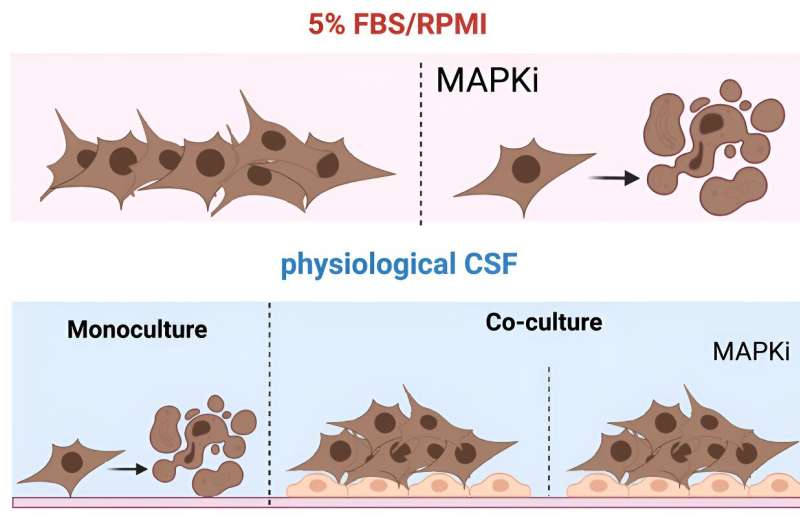This article has been reviewed according to Science X's editorial process and policies. Editors have highlighted the following attributes while ensuring the content's credibility:
fact-checked
peer-reviewed publication
trusted source
proofread
Study reveals new mechanism of drug resistance in melanoma leptomeningeal disease

Leptomeningeal disease is a rare but lethal complication faced by late-stage melanoma patients. It occurs when cancer cells spread to the membranes covering the brain and spinal cord, or the leptomeninges. This condition, which affects 5% to 8% of melanoma patients, often leads to rapid deterioration and is notoriously resistant to therapies. However, a new Moffitt Cancer Center study, published in Cell Reports Medicine, uncovers the mechanisms that drive this drug resistance, offering new avenues for potential treatments.
Moffitt researchers analyzed tissue specimens from patients with leptomeningeal disease and compared them with metastases from other body parts in the same individuals. They found that melanoma cells in the leptomeninges interact significantly with stromal cells. Under healthy conditions, stromal cells play crucial roles in maintaining the health and function of various tissues and organs in the body. In melanoma leptomeningeal metastasis, the interactions between these stromal cells and the tumor activate tumor-promoting signals.
"Understanding the unique environment of leptomeningeal metastasis in melanoma has been a major challenge. Our findings demonstrate that the 'normal' stromal cells in the leptomeninges play a crucial role in supporting tumor growth and resistance to MAPK inhibitors, a common melanoma treatment," said Inna Smalley, Ph.D., senior author, assistant member of the Department of Metabolism and Physiology and a member of the Donald A. Adam Melanoma and Skin Cancer Center of Excellence.
The researchers' cutting-edge spatial transcriptomics analysis uncovered spatially driven signaling pathways associated with melanoma growth and drug resistance, particularly in regions where tumor and stromal cells interact. They identified the protein SERPINA3 as a regulator of tumor-stroma interactions, suggesting a potential target for therapeutic intervention.
"Our data suggest that targeting the tumor-stroma interaction, particularly through inhibition of SERPINA3-mediated signaling, could represent a novel strategy to overcome drug resistance in melanoma leptomeningeal disease," Smalley said. "By disrupting this critical interaction, we may be able to enhance the efficacy of existing therapies and improve patient outcomes."
The study also highlighted melanoma cells' unique metabolic challenges in the cerebrospinal fluid. The team demonstrated that the meningeal stroma is essential for melanoma cells' survival in this harsh environment, further underscoring the importance of the tumor-stroma interaction.
More information: Hasan Alhaddad et al, Spatial transcriptomics analysis identifies a tumor-promoting function of the meningeal stroma in melanoma leptomeningeal disease, Cell Reports Medicine (2024). DOI: 10.1016/j.xcrm.2024.101606



















